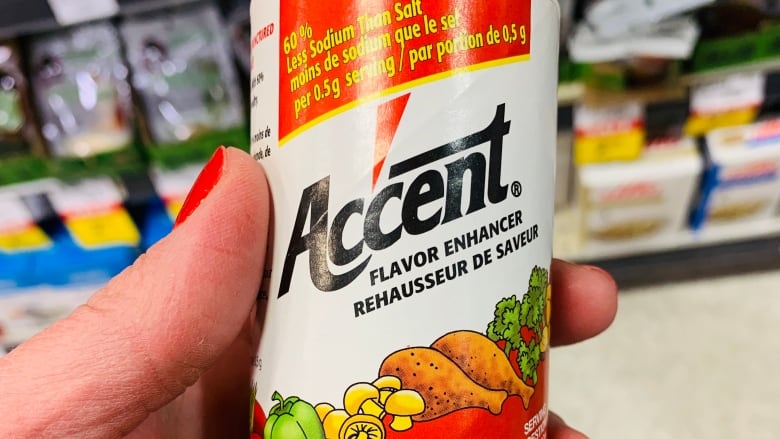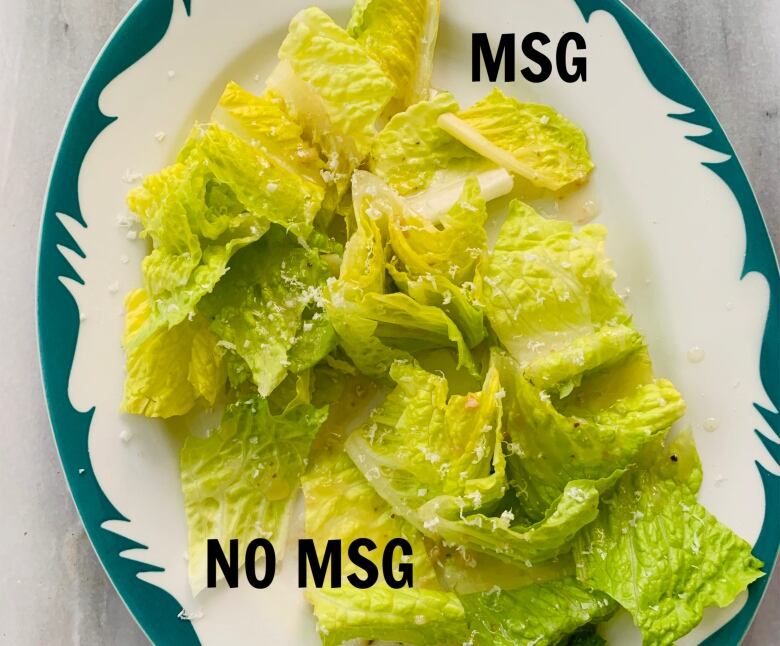The argument for MSG: Taste test, scientific research show additive is yummy and safe
Food columnist Julie Van Rosendaal finds incorporating the ingredient adds savoury sensation

Although most of us recognize the acronym "MSG," not many could explain exactly what it is.
It'ssavoury flavour enhancer that's so common in Asian cooking, it's sold in shakers to add both in the kitchen and at the dinner table.
But MSG, or monosodium glutamate, has long been misunderstood, having suffered from unsubstantiated controversy in the western world.
The additive, in fact, makes food yummy and it's safe Health Canada and scientists worldwide agree.
A little taste we did on the Calgary Eyeopener suggests a sprinkle inyour cooking adds a savoury sensation.
- Bookmark cbc.ca/juliesrecipesto keep up with all of Julie Van Rosendaal's dishes
The additive comes from a naturally occurring amino acid called glutamic acid. One of the most abundant naturally occurring amino acids, it makes up 10 to 25 per centof all food protein, from both animal and vegetable sources.
Glutamate occurs naturally in the human body and in foods that we associate with umami: meat, tomatoes, mushrooms, soy sauce and Parmesan cheese. It also occurs in large quantities in breast milk.
The isolation of glutamate in 1908 was a culinary breakthrough, when University of Tokyo chemistry professor Kikunae Ikeda first extracted it from dried kombu(kelp).
The professor went on to identify it as umami, the fifth basic taste,joiningsalty, sweet, sour and bitter. Ittranslates into "pleasant savoury taste."

In the western world, MSG still feelsthe effects of some bad press. In 1968, someone theorized that he was having an adverse reaction to it and wrote a letter to the New England Journal of Medicine, which published it, creating controversy around any food that contained MSG.
Of course, it could be that he was affected, as people can have allergies and intoleranceto all types of food.
But the safety of MSG has been thoroughly studied by scientists and regulators worldwide, including the World Health Organization and Health Canada, and the general consensus is that it's not a health hazard.
MSG doesn't make the list of most common food allergens, and the Federation of American Societies of Experimental Biology determined there is no difference in the physiological response to synthesized and natural glutamates.
No hazard, Health Canada says
Health Canada agrees. In a post online, the national regulator notes leading international authorities have found that MSG does not present a health hazard to humans, nor can it be linked to obesity.
In developing MSG, Ikeda added sodium, one of the elements of table salt, to stabilize the glutamate, allowing it to be easily added to, or sprinkled over,food. It looks like sparkly white sugar crystals but it's savoury.
The most popular brand worldwide is Aji-no-moto (which translates to "essence of taste"), headquartered inTokyo. The brand Ac'cent, which was introduced in 1947, is morecommonly found on Canadian grocery store shelves.
While it's far more common to see a shaker on the table in Japan and other Asian countries, where there has never been cause for concern, we don't give a second thought to its presence in packaged foods, such as Doritos, Pringles, canned soup, ramen noodles and other items designed to deliver a flavour punch.

Health Canada does advise some highly sensitive people can experience allergic-type reactions, such as temporary headache, nausea and chest pains. Those people may wish to avoid the ingredient.
MSG is not regulated as a food additive in Canada, and can appear in ingredient lists under different names. Manufacturers aren't required to list ingredients with naturally occurring MSG, either.
It's usually at the end of the list because ingredients are listed in order of quantity.
"Claims pertaining to the absence or non-addition of monosodium glutamate such as 'contains no MSG', 'no MSG added' and 'no added MSG' are considered misleading and deceptive," Health Canada says.
Other sources of free glutamate may bepresent, such ashydrolyzed vegetable protein, hydrolyzed plant protein, hydrolyzed soy protein,soya sauce or autolyzed yeast extracts. Common food, such as tomatoes and tomato juice, grapes and grape juice, and mushrooms, all have high level of naturally occurring free glutamate.
Taste-testing MSG
Our in-studio taste test determined that a sprinkle of pure MSG made tomato soup with Parmesan and roasted garlic caesar salad dressing more palatable. It gavehoisin pork lettuce wraps a more "meaty" taste.
A shake made sliced cucumbers more intensely cucumbery, and a few of us noted that the flavour tended to linger longer than usual, a characteristic that would be well-suited to a bag of Doritos.

You can find shakers of pure MSG among the salts, spices and other seasonings when you go grocery shopping. Think of it as a flavour booster that's slightly salty, with a umami edge.
It kind of does to food what the chrome filter on your iPhone camera does to photos:saturating and intensifying them, making the colours a more vibrant, stimulating version of themselves.
- JULIE'S RECIPES|Julie Van Rosendaal's favourite Ukrainian recipes
- JULIE's RECIPES|Healthy meals on-the-go to replace fast food this busy time of year
This column is an opinion. For more information about our commentary section, please read this editor's blog and our FAQ.
With files from the Calgary Eyeopener.












_(720p).jpg)


 OFFICIAL HD MUSIC VIDEO.jpg)
.jpg)



























































































